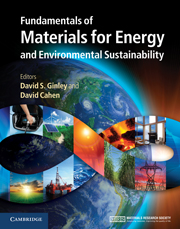Book contents
- Frontmatter
- Contents
- Contributors
- Preface
- Acknowledgments
- Part 1 Energy and the environment: the global landscape
- 1 A primer on climate change
- 2 The global energy landscape and energy security
- 3 Sustainability and energy conversions
- 4 Energy cost of materials: materials for thin-film photovoltaics as an example
- 5 Economics of materials
- 6 Global energy flows
- 7 Global materials flows
- 8 Carbon dioxide capture and sequestration
- Part 2 Nonrenewable energy sources
- Part 3 Renewable energy sources
- Part 4 Transportation
- Part 5 Energy efficiency
- Part 6 Energy storage, high-penetration renewables, and grid stabilization
- Summary
- Appendix A Thermodynamics
- Appendix B Electrochemistry
- Appendix C Units
- Index
- References
3 - Sustainability and energy conversions
from Part 1 - Energy and the environment: the global landscape
Published online by Cambridge University Press: 05 June 2012
- Frontmatter
- Contents
- Contributors
- Preface
- Acknowledgments
- Part 1 Energy and the environment: the global landscape
- 1 A primer on climate change
- 2 The global energy landscape and energy security
- 3 Sustainability and energy conversions
- 4 Energy cost of materials: materials for thin-film photovoltaics as an example
- 5 Economics of materials
- 6 Global energy flows
- 7 Global materials flows
- 8 Carbon dioxide capture and sequestration
- Part 2 Nonrenewable energy sources
- Part 3 Renewable energy sources
- Part 4 Transportation
- Part 5 Energy efficiency
- Part 6 Energy storage, high-penetration renewables, and grid stabilization
- Summary
- Appendix A Thermodynamics
- Appendix B Electrochemistry
- Appendix C Units
- Index
- References
Summary
Focus
Energy use is inexorably woven into the fabric of modern civilization. Human well-being, economic productivity, and national security all depend on the availability of plentiful and affordable energy supplies. However, over the past half century, we have come to understand that continued growth of energy use along the lines of current energy systems will lead to unacceptable consequences for the Earth's climate and oceans. Maintaining and increasing the access to energy services to satisfy crucial societal needs requires the development of a sustainable global energy system that transitions away from energy supply options with high greenhouse gas (GHG) emissions and unhealthy air pollutants. Disparity in energy access is also not sustainable. We must provide sufficient energy for the estimated 1.6 billion people who do not have access to modern energy systems today. Fortunately, plentiful energy resources are available to meet our needs, and technology pathways for making this transition exist. Continuing to lower the cost and increase the reliability of energy from sustainable energy resources will facilitate this transition. Changing the world's energy systems to reduce GHG emissions is one of the critical challenges that humans must face in this century. The required transition can begin now with improvements in efficiency of energy conversion and use, and with continuing deployment over the coming decades of a variety of existing and innovative technologies. With continuing attention to energy conversions that minimize wastes, have low life-cycle impacts, and maximize recycling of materials, a set of sustainable energy systems can be created.
Synopsis
Feeding, clothing, and housing a growing world population will be a significant challenge in this century, as will supplying the fresh water, heat, lighting, and transportation we will need to live comfortable and productive lives. This chapter discusses energy sustainability, with emphasis on the requirement to reduce GHG emissions. A sustainable energy system is one in which energy is supplied and converted to energy services in ways that avoid unacceptable consequences for local, regional, and global natural systems that control climate and support ecosystems that provide essential services. Figure 3.1 illustrates typical conversions of a primary energy resource (solar, wind, geothermal energy, fossil or nuclear resources, etc.) into a product, such as a fuel or an energy carrier, like electricity, that then can be converted to a service like heat, light, or mechanical work. Sustainable processes and systems that convert some primary energy resource into energy services will be ones that are as efficient as possible – smaller quantities of the primary energy resource are needed and fewer waste materials are created if the conversions are efficient. Some have argued that only energy flows such as solar, wind, and wave power should be considered sustainable. Others note that any system of energy conversions has some footprint and impact, and that sustainability is necessarily a relative measure, not an absolute one. In any case, sustainable systems will have low impacts over the full life cycle of the conversions (see Chapter 41). Recycling of materials used in energy conversions will be maximized, and amounts of waste materials created in the chain of energy conversions to services will be minimized when the whole cycle from primary resource to services (such as mechanical work) to waste heat and products is considered.
- Type
- Chapter
- Information
- Publisher: Cambridge University PressPrint publication year: 2011
References
- 1
- Cited by



